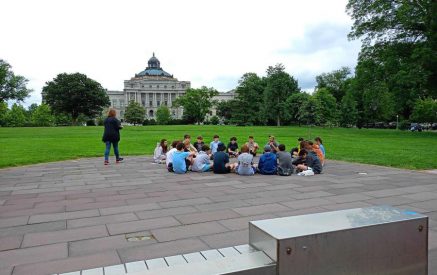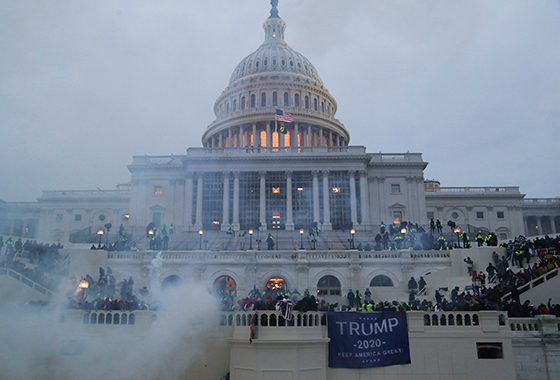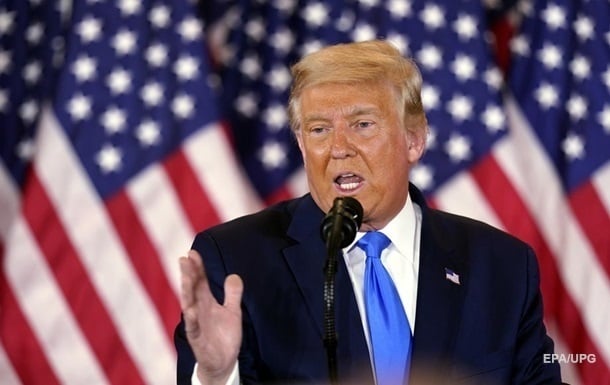By Katherine Jacobsen/CPJ U.S. Research Associate and Lucy Westcott/James W. Foley Emergencies Research Associate
Pro-Trump protests in Washington, D.C. — during which a mob broke into the Capitol building and forced journalists, lawmakers, and staff to shelter-in-place for hours — were full of anti-press sentiment. The words “Murder the Media” were etched on a door inside the building, according to The New York Times, and individuals in the crowd repeatedly threatened reporters and smashed their equipment.
The U.S. Press Freedom Tracker, of which CPJ is a founding member, is investigating at least three arrests, six assaults, and multiple reports of equipment damage, threats, and harassment of members of the media.
To better understand the situation on the ground, and the conditions for the press, CPJ spoke with several journalists via phone who reported in and around the Capitol building. The interviews have been edited for length and clarity.
Read also
Amanda Andrade-Rhoades, freelance photojournalist on assignment for The Washington Post
What time did you get the Capitol yesterday and what was it like?
I arrived right around 10 a.m. and things were relatively sedate. Some of the protesters were rude to the media and others just kind of ignored us. As I was walking around the Capitol later in the day, I realized things were going to heat up rather quickly, so I put on my gas mask. Protesters started dismantling barricades around the Capitol to hit the police officers and began to fight them. When the police were struggling to get control of the barricades, they started firing rubber bullets. I also saw pepper spray being deployed, and what I think was tear gas, but it was hard to tell with my gas mask. When this was happening, around 2:45 p.m., I was hit with rubber bullets.
Why do you think the police were so overwhelmed by protesters?
I got the sense that they were wildly underprepared and outnumbered. I don’t think they expected that the protesters would be so aggressive toward them. I’ve covered other pro-Trump rallies before and they were really reticent to go toe-to-toe with the police beside shouting, so I think the Capitol Police were taken off guard. They just did not have the numbers to fend off protesters. They had a lighter hand than what I’d seen throughout summer, but those were other police forces.
Did the crowd express animosity toward you as a member of the media?
Oh yes, I had three different people threaten to shoot me over the course of the day. They weren’t armed as far as I could tell. I saw people with knives and pepper spray. If they had guns, I couldn’t see them. But I did see people in flak jackets and bullet proof vests, so clearly ready for armed combat. At one point, a guy leaned over to me and said, “I’m coming back with a gun tomorrow and I’m coming for you.”
I had a man get in my face as I was trying to photograph a broken window. He asked me “Are you Antifa?” My credential was hidden, but my gas mask, which I was wearing at the time, said press. A Capitol Police officer actually told him to back off. He said, “No she’s media, stop.”
How do you deal with that and remain calm?
I almost just don’t really process it until it’s done. There are some things that are automatic now: keeping an exit open and really paying attention to my gut if someone seems really hostile. There were moments where I could see a person following me and watching me and that’s when I knew that I need to get lost in this crowd and watch out for this person. I don’t process that fear until it’s done. I can’t let it get to me, so I just don’t think about it until it’s done for the day.
I’m no longer taking safety in the Capitol for granted. I’ve been in before covering politics. I’ve dealt with protesters there and I’ve never felt threatened before. Now I think I’m just going to be a lot more cautious.
Richard Hall, British journalist and a senior U.S. correspondent for The Independent
What was the scene like when you arrived at the Capitol?
I arrived shortly before 11 a.m. [for Trump’s speech]. I watched him give a speech he’s given many times before at rallies and campaign events, but this was the first time he’d given this kind of speech in front of the White House. It had a different feel, a different meaning in my eyes. You could see people were angry and they were eating up every word. While he was speaking he abruptly announced that the march was going to the Capitol building. Before he’d even finished speaking, people were leaving and started walking down. It was a trickle at first and by the time he’d finished, everyone was outside the Capitol building.
I went to the front and there were about 100 people kitted out in kneepads, helmets. Some were in military fatigues. There was a core group that was trying to push through police lines on the steps on the Capitol. That went on for about an hour, and there was some tear gas fired by police.
You briefly went inside the Capitol building with the protesters. What happened when protesters breached the police lines and got inside?
During the first breach it was way too crowded for me to get through. There was a queue of hundreds of people trying to get through this narrow gap in the scaffolding that they’d broken through. I walked around to the side of that bit and there were people climbing up the wall to try and get in. At this point, I’d stopped identifying myself as a journalist and put my press badge away under my jacket and just followed them to document what was going on.
There were tons of people wearing t-shirts saying things like “Hang the media.” I’ve seen those t-shirts before at rallies and campaign events, but they’re usually pretty orderly affairs. This was slightly different because the police had been pushed back. It was essentially a mob. They were shouting all sorts of slogans and horrific stuff about [U.S. House Speaker] Nancy Pelosi. They were fired up. I decided to go with the crowd. I stopped doing interviews at that point.
I climbed up a wall to try and get in. The protesters were helping me up the wall and I got to the top of a wall on the side of the building. I saw it was too crowded, so I climbed back down, walked around the corner and saw that there was just no police presence on the other side. I followed a group who barged their way into the building on the east side, where the press gallery is. We got into the lobby and we were in there for 10 to 15 seconds before police fired tear gas into the lobby from further inside. I dipped out of there pretty quickly. There wasn’t as much tear gas as I thought there would be; it was pretty mild. I was mostly on the steps of the Capitol building for about an hour, an hour and a half.
Later in the day you tweeted a photo of damaged news equipment with the caption, “Today was the first day I’ve felt uncomfortable identifying myself as a journalist in America.” What made you tweet this?
I’d already gone home by the time I tweeted that. That’s a luxury I have that TV journalists don’t have. They have all this gear and equipment; they can’t just blend in like I did. I felt very fortunate that I was able to do that. It speaks to the last four years. Donald Trump has turned the press into an enemy and that stuff filters down. I’ve never normally been bothered by it because no one’s going to attack you at a rally. They might turn around and shout at you, and Donald Trump encourages that, but they’re not going to do anything. But when it’s an unrestrained, mob-like mentality like that, it did feel a bit unsafe for a while.
Audrey Fahlberg, reporter on a post-college fellowship at U.S. center-right outlet The Dispatch
How did people outside the Capitol respond to you when you identified yourself as a member of the press?
I attended the Million MAGA March in November, so I knew what I was getting into. These people hate the media and the Democratic Party almost equally. You walk in there knowing you’re going to get threats, knowing you’re going to be mocked for wearing a mask. I heard some off-hand remarks, “Oh, she’s wearing a mask, she must be from the media.” Everywhere people were holding signs that said COVID-19 isn’t real.
The Dispatch was launched in 2019. We’re a center-right media company, and we’re Trump-skeptical, anti-Trump. When I go up to people, I’m very honest about who I am. A lot of people said no, they didn’t want to speak with me. I wasn’t attacked or anything, but for the most part people asked, “Are you going to twist my words?” I told them that I am going to report exactly what they say. Most people were willing to talk to me. It was pretty astonishing to see how many people were proud of the occupation of the Capitol while speaking to me and were willing to go on the record.
What was the scene like outside the Capitol?
I did not go inside the Capitol. My younger sister came with me because she didn’t want me to go alone. I truly could not believe what was transpiring before my eyes. People were climbing the scaffolding. The entire terrace was chock full of protesters. The magnetism of the crowd was astonishing. These people had travelled thousands of miles across the country and they truly believed that the election was stolen from them. My younger sister was separated from me at one point. She was immediately badgered by four male Trump supporters who asked her, “Who are you? Are you with the media?” She just cowered in response, said she was looking for her sister, and they eventually left her alone. These people were really intimidating.
In the afternoon, I was interviewing people right next to the Capitol. During my interview all of these tear gas bombs started going off. They sounded like fireworks; I’ve never been in that situation before. It was really terrifying. Luckily the tear gas didn’t get in my eyes. It was really bizarre, all of these MAGA rally attendees kept coming up to me and comforting me and saying, “Oh sweetie, you’re going to be fine, it’s just tear gas, we’ll get through this together.” I’m thinking to myself, “I’m not with you people.” I wasn’t personally assaulted or harassed in any way, but it was still scary being there even with an N95 mask. There were so many people confined in such a small space.
How do you feel now about your safety as a journalist?
This is a truly terrible and historic moment in American history. Reporting on this, there was a huge adrenaline rush that I experienced and there was a moment that I thought to myself, “This is what I’m meant to do.” It was an honor being able to cover this as a young reporter. I understand why some journalists would be afraid to go back out there. I’d happily do it again, and it’s important to record history, but I’d be lying if I said it wasn’t scary.
Zoeann Murphy, Washington D.C.-based video journalist for The Washington Post
You had the afternoon shift for live-streaming. How did you prepare for the events?
Before heading out, I quietly, and in a focused way, made sure I had everything and that all of my batteries were charged, my memory cards formatted, and that I had the right eye protection. I really took my time, almost as a meditation, to make sure I was prepared for various situations. I think this was really important because it allowed me to walk into the scene and really focus on what was unfolding in front of me.
I had on body armor, including a level IIIa vest and a helmet, and was clearly identifiable as a Washington Post journalist. I also had a gas mask, though I was mostly wearing a surgical mask, and a first aid kit in my pack.
What was the scene like when you arrived?
We always use the buddy system, so I met up with a colleague and we arrived to the area around the Capitol together about 4 p.m. We were relieving a few colleagues and they were really shook. Some of them had really been harassed by protesters. The demonization of the press was palpable.
I’ve covered so many protests I’ve lost track of how many, but this was really, really striking. It was chaos with smoke bombs exploding here and there, a lot of flags and screaming, and phrenetic, angry energy. Things were so chaotic by the time we got there that a lot of attention wasn’t focused on us, though some people were yelling nasty things. I was focused on filming and wasn’t really chronicling what people were saying.
Did anything stand out to you while filming?
I was at this one door to the Capitol and there was a mob of over 100 people at this door and you could see the glass was cracked and there was a line of police on the inside of the door in full riot gear. I was up high on a column and could see protesters yelling angrily at protesters on the other side of the door. This one woman who had been participating and she said “Stop, stop, everybody stop.” A small group of people quieted down and looked at her. She said that the president tweeted recently that the Capitol Police are on our side and we should respect the Capitol Police. She said it probably 15 times, she kept saying it over and over. And then a small group of people left with her. It was just really an indicator to me that, whether the president was intentionally directing protesters or not, the protesters were taking his messages as direction.
You were detained by the police. What happened?
We were there in the evening and police were clearing the demonstrators out. We got caught in a police kettle, which was surprising. In past instances, I’ve always been able to walk up to the police and tell them I’m a journalist, and they will let me out. But these officers were really intent on pinning us in.
I wanted to leave the kettled area because it looked a little bit tense, and I didn’t want to be in the middle of a confrontation. At that point I called my editor and as I was talking to my editor, a police officer grabbed me by the shoulder, and another grabbed my colleague by the shoulder and walked us toward the buses. I asked if we were being arrested and they said “Yes, just deal with it.” We got led toward the van and right before they searched us, when it was our turn to get on the buses, a female officer ran toward us and asked us if we were media and let us both go.
[Editor’s note: Kristen Metzger, a D.C. Metropolitan Police Department spokesperson, told CPJ via phone that two Washington Post journalists were briefly detained.Capitol Police did not respond to CPJ’s request for comment via email.]
Committee to Protect Journalists























































